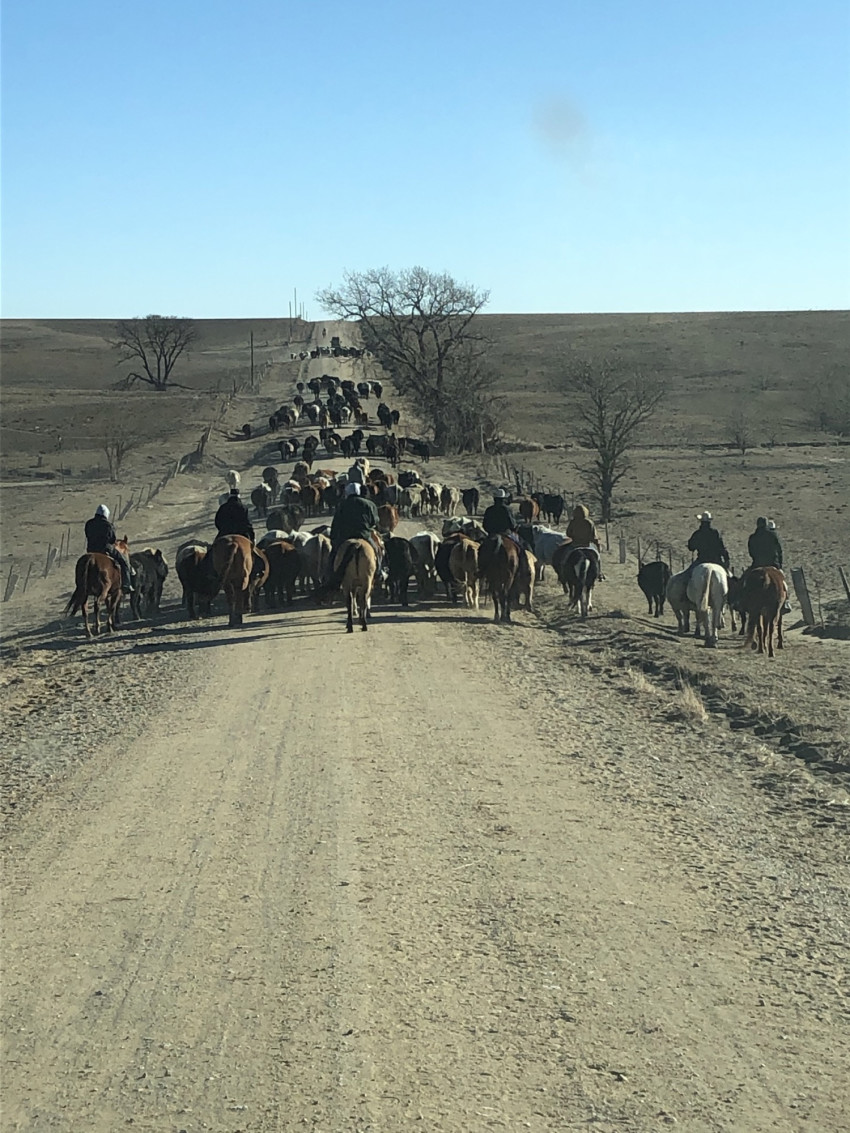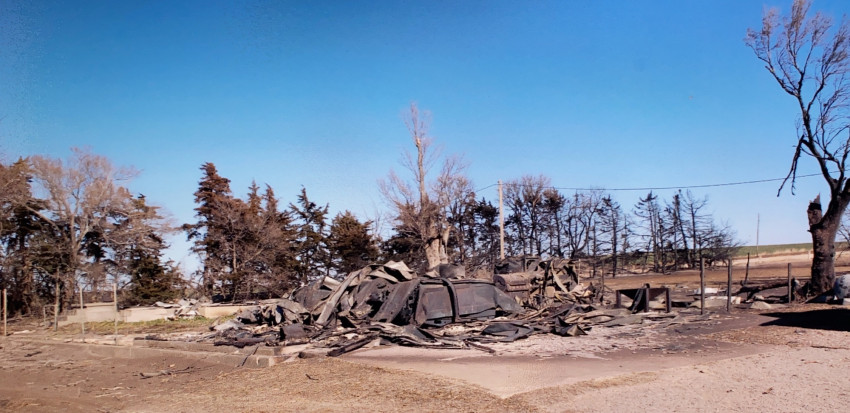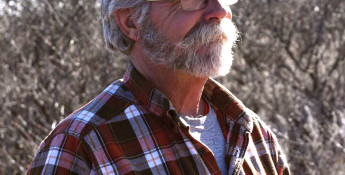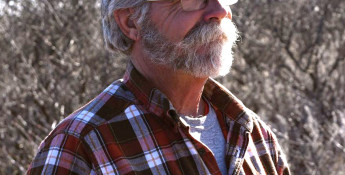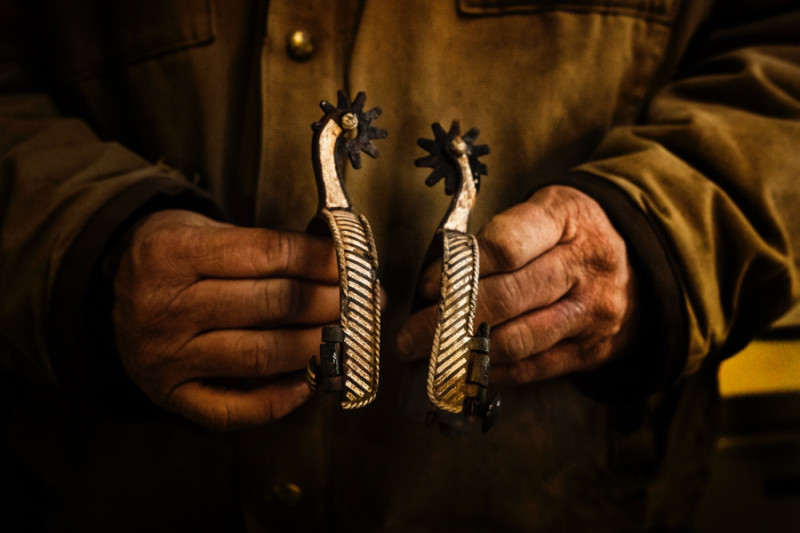By Greg Doering on November 9, 2022
Kansas Farmers and Ranchers Remain Resilient After Wildfire
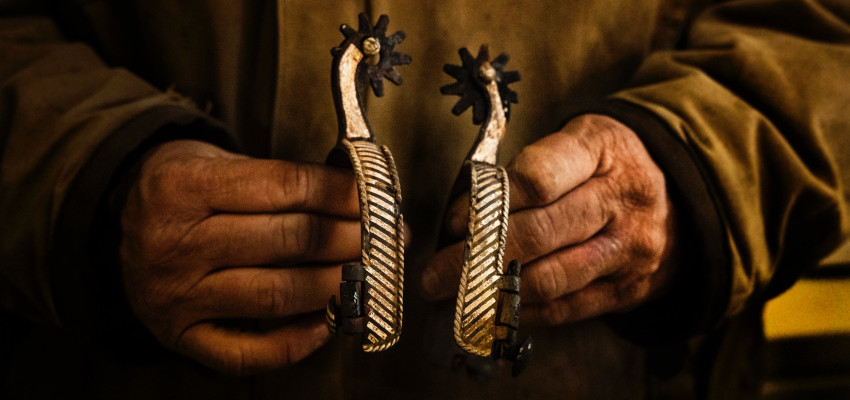
Stephanie Dickerson spent an “eternity” on Dec. 15, 2021, huddled with her husband, son, a neighbor and a hired hand in the cab of a pickup truck as a wildfire made the doors too hot to touch. It didn’t matter that they were parked in the middle of a green wheat field. It didn’t matter that a volunteer firefighter was dousing the vehicle with water from a tanker truck. The heat was still seeping into the cab.
“They basically poured water on us for about 15 or 20 minutes,” Dickerson says. “The only thing not burned in that field was the circle where we were all sitting with the tanker truck.”
It wasn’t Dickerson’s first close call with fire that day, and it wouldn’t be the last for the fourth-generation rancher who, alongside her family, operates the Bar S Ranch in the Smoky Hills region north of Russell near the town of Paradise.
They raise purebred Angus, red Angus and Charolais they primarily sell to other ranchers looking to incorporate those genetics into their herds. The Bar S has a retained ownership program in place for its commercial cattle, managing the herd through the processing stage to collect carcass data.
The ranch and surrounding territory became the heart of what’s called the Four County Fire that charred more than 120,000 acres — or just shy of 200 square miles — across portions of Ellis, Osborne, Rooks and Russell counties. Fires across central and western Kansas burned another 40,000 acres that day.
Recipe for disaster
The groundwork for the December disaster was set long before fires swept through the area. A wet spring caused rapid growth across the prairie, but the monthslong drought that followed not only dried out the ground but also withered the ample grass and desiccated fallen trees.
Sustained southern winds in excess of 70 mph pushed the temperature in Paradise to 75 degrees on Dec. 15. The atmosphere served as a kiln, drawing every ounce of moisture from the vegetation and creating a tinderbox primed to ignite at the slightest spark.
By early afternoon, it became a question of not if but when a spark would ignite a firestorm. Volunteer firefighter and rancher Dustin Finkenbinder says he was helping his children unload FFA fruit baskets at the Waldo Community Center a little after 2 p.m. when he heard the first siren go off. “You just felt absolutely sick to your stomach because you knew it was going to be bad,” he says. “No matter if you got there in time or not.”
Invisible danger
The combination of high winds and drought created a dust storm so bad it limited visibility to less than a quarter mile, making it nearly impossible to spot a fire from any distance or judge its path.
“We actually had to find that first fire by smell,” Finkenbinder says. “Once we found it, we got to work on it. We were actually making some progress, and that’s when the real wind started — we got those gusts of 100 mph or more.”
Finkenbinder says the closest any of the volunteer firefighters had ever come to an event like Dec. 15 was a fire near Wilson Lake, about 30 miles southeast of Paradise, where the winds blew 60 to 70 mph. But there was one significant difference.
“It was clear skies and sunny,” he says of the Wilson Lake fire. “This looked like midnight at 5 o’clock in the evening.”
Finkenbinder says the last call related to the Four County Fire came in at about 8 p.m. on Christmas Eve, meaning volunteer firefighters spent the 10 days before Christmas battling fires and watching hotspots to preserve what hadn’t yet burned.
Helping a neighbor
Stephanie Dickerson and her family were in their barn preparing show cattle for the Cattleman’s Congress in Oklahoma City. Around noon, Dickerson noticed the wind picking up, enough that it lifted the roof off the rafters by several inches.
“I told my husband, ‘This is not normal,’” she says. “If there’s a fire, it’s going to be really bad.”
A couple of hours later, neighbors called asking for help evacuating their horses because a fire had broken out near their homeplace. Dickerson’s husband David and one of their sons got in one truck with a trailer in tow while Dickerson and a hired hand followed in a second for what is usually a 10- to 15-minute drive.
By the time their convoy arrived 45 minutes later, the neighbors had turned the horses loose to fend for themselves. The Dickerson crew began the trek home, heading south back to the Bar S. That’s when the real trouble began. David was driving in the lead position going around a curve when the wind caught the trailer and flipped it and the truck on its side. The trailer on Stephanie’s vehicle also blew over, but it disconnected from the hitch without wrecking her truck.
The occupants in David’s truck were extracted from the vehicle unharmed and climbed into Stephanie’s truck. They drove north until they hit a wall of fire. They turned around and tried backtracking, but soon they were surrounded by fire.
“I took the ditch and drove for a quarter mile with fire going over the top of us,” Dickerson says. “It was a surreal moment. There were flames shooting under the hood and over the top of the windshield. The plastic mirrors melted and dripped off the truck.”
They eventually met up with the volunteer firefighters near where the truck and trailer overturned. From there they returned to the neighbor’s house, picked up an additional person and continued on in search of a way out before getting trapped in the wheat field.
Taking inventory
Near Waldo, another green wheat field was the only thing that stood between the fire and Finkenbinder’s home. Thankfully, a lower amount of flammable material around the field and the wheat’s higher moisture content at the time helped extinguish the fire.
“It burned the ditch off next to one of our green wheat fields,” he says. “If that hadn’t been wheat, it would have made it to our farm and our cattle and our hay. We were very lucky.”
Tanner Lyle, another rancher in the area, says he escaped the fire relatively unharmed, losing about 10 miles of fence, a calving shed and other items to the fire and wind-related damage. Lyle had cattle near some of the worst parts of the fire, grazing on milo stalks that had been stripped bare by the wind, preventing the spread of fire. His in-laws were less fortunate, losing their house and more than 80 percent of their herd.
“They spent years developing their cattle herd and they’re pretty much starting from scratch,” he says.
Stephanie Dickerson could see the fire’s impact even before they made it home, just as dusk was settling over the countryside.
“As we got closer, we could see the tree belt north and west of the house was on fire, our house was on fire and we lost five barns,” she says, before ticking off the rest of the inventory stolen by flames: more than 200 head of cattle, another house, 55 miles of fence, more than 4,000 big round haybales and her three dogs.
“I had left our dogs in the house thinking that was going to be the safest place for them,” she says. “Our house was on fire and I’m a mess, telling my husband we’ve got to stop. I’ve got to see if I’m able to save the dogs. But in your mind, you know you’re not going to be able to save them.”
Dickerson ran down her driveway, pulling the hood on her coat up to block the flying embers from settling in her hair. She grabbed her purse out of a pickup that had two tires fully engulfed with flames. Her husband grabbed the calf book and tagging box from another vehicle. They were the only personal items retrieved.
Outpouring of support
Lyle says he was able to fix his fence by the fall, and with enough moisture, the pastures will return to their previous production in a season or two. For others, like his in-laws, the scars will take longer to heal. The generosity of fellow farmers and ranchers helped soften the blow for everyone.
“I’ve been impressed with the generosity of the ag industry and people who sent donations,” Lyle says.
Dickerson likened the outpouring of support to attending her own funeral.
“You get to see people that show up who care about you,” she says. “People we didn’t even know came. They just wanted to help. The day after the fire we had probably 300 people show up at our house asking, ‘What can we do?’”
Friends offered the Dickersons a place to stay as they figured out where to begin the recovery process, which was aided by more volunteers than they ever expected.
“We had between 20 and 30 FFA chapters show up on weekends, give up their spring break or show up for an afternoon to help us with cleanup, help us tear out fences — anything we asked them to do,” Dickerson says. “Those kids were just great.”
County Farm Bureaus and the state office joined other organizations to host a meeting to provide information on resources and support for farmers and ranchers affected by the wildfires shortly after Christmas. More than 300 people were able to attend in person, and another 120 watched the meeting online.
“Just what you do”
Nearly a year after the fire, Dickerson and her husband have had plenty of time to replay the events of Dec. 15 over in their minds, to second-guess their decision to leave their home, herd and most of their worldly holdings to the whims of a wind-fueled wildfire and help a neighbor.
Their minds haven’t changed a bit.
“I can honestly tell you that if put in the same situation again, I would do exactly what we did,” Dickerson says. “If someone called me today, I’d go and help a neighbor. That’s just what you do.”
Help with prevention and recovery
If you’re interested in helping Kansas farmers and ranchers recover from devastating wildfires, the Kansas Livestock Association offers a place to donate. These donations are tax deductible, and all proceeds are distributed to producers impacted by wildfires.
Visit www.kla.org/resources/ wildfire-relief-resources for more information or to donate.
Preventing wildfires takes all of us. Whether you live in the city, a suburb or a rural area, being cautious when it comes to fire is important for everyone’s safety. The Office of the State Fire Marshal website, firemarshal.ks.gov, offers prevention tips for home fires, wildfires and more. Also, be sure to check out the free alarm program, Get Alarmed Kansas, which allows trained volunteers to install free smoke alarms in homes.


